Barefoot with the devout
Sabarimala temple, India -- There I was, one of tens of thousands of people, mostly men, trudging barefoot uphill to the Sabarimala temple. Monkeys screeched as they swung along the branches above. I silently cursed the bathroom slippers that I had worn for the occasion and prayed that my cover as a tourist would hold.
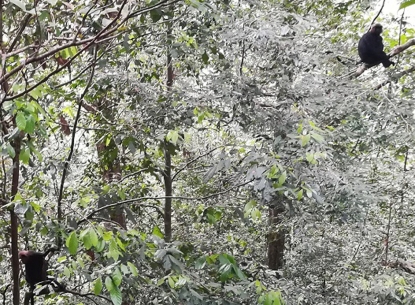 Monkey companions along the hike up to the temple. (Photo courtesy of Bhuvan Bagga)
Monkey companions along the hike up to the temple. (Photo courtesy of Bhuvan Bagga)I had never imagined that I would be here, trekking to one of the holiest Hindu temples, in India’s southern Kerala state, a pilgrimage undertaken only by the most devout followers of Lord Ayyappa.
Hinduism doesn’t have a single holy book or a single authority on the practice of the religion. So customs, practices and beliefs of Hindus vary from region to region, with the main thread being the three main Hindu gods. So as a practicing Hindu from New Delhi, I never thought I’d travel more than 3,000 kilometres (1,860 miles) just to visit a temple where practices were so much different from what I was used to.
Earlier that day, I had somehow reached the base camp for the steep ascent after a thrilling, hours-long adventure. Kerala state -- otherwise known for its pristine beaches, backwaters and Ayurvedic therapies -- had turned into a high tension battleground over the last few days.
The reason was India’s Supreme Court, which had lifted a ban on women aged 10 to 50 entering the sacred hilltop shrine. The decision sparked virulent protests by devotees and local Hindu organizations and I went to cover the unrest.
The court decision set up a clash between devout Hindus and women rights activists. Women are permitted to enter most Hindu temples and activists argued that the restrictions at Sabarimala reflected an old belief that menstruating women are impure.
While women’s rights activists cheered the court’s ruling, traditionalists were enraged.
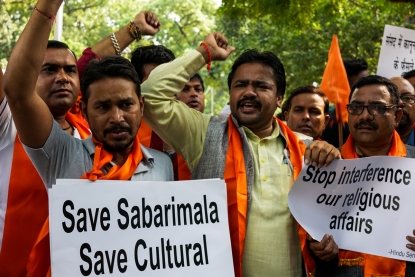 Members of Hindu right-wing group Hindu Sena protest against the Supreme Court decision to allow women to enter Sabarimala temple. New Delhi, October 4, 2018.
(AFP / Chandan Khanna)
Members of Hindu right-wing group Hindu Sena protest against the Supreme Court decision to allow women to enter Sabarimala temple. New Delhi, October 4, 2018.
(AFP / Chandan Khanna)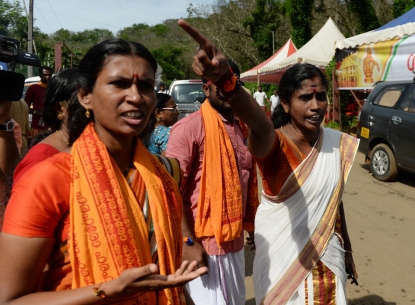 Indian Hindu devotees and activists protest being stopped by police during a protest against the Supreme Court decision to allow women into Sabarimala temple. Kerala State, October 17, 2018.
(AFP / Arun Sankar)
Indian Hindu devotees and activists protest being stopped by police during a protest against the Supreme Court decision to allow women into Sabarimala temple. Kerala State, October 17, 2018.
(AFP / Arun Sankar)
The day before, October 17, I had reached Nilackal -- the first of two basecamps before the final trek up to the temple -- with colleagues Arun Sankar, photojournalist and video journalist Archana Thiyagarajan.
It was a charged atmosphere with tens of thousands of devotees arriving on buses, cars, pickup trucks or on foot.
These devotees, mostly men with many older women and young girls, from different backgrounds and corners of the country -- marched past Nilackal, chanting hymns and devotional songs.
Hundreds of policemen in riot gear closely watched over what can be best described as a colourful and spirited organised chaos.
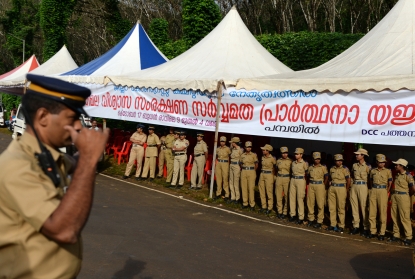 Indian policewomen stand guard while Indian Hindu devotees and activists protest against the Supreme Court decision allowing women to enter the Sabarimala temple. Kerala State, October 17, 2018.
(AFP / Arun Sankar)
Indian policewomen stand guard while Indian Hindu devotees and activists protest against the Supreme Court decision allowing women to enter the Sabarimala temple. Kerala State, October 17, 2018.
(AFP / Arun Sankar)As a journalist who has covered dozens of riots and riot-like situations across the region over the last few years, the question wasn’t if, but when and how things would get out of control.
Soon enough, we saw the first signs of it when the three of us tried to reach Pamba, the final basecamp accessible by motorised transport before the climb.
Our hired cab was suddenly surrounded by a dozen men, some of them banging on its bonnet and pointing towards Archana. They wanted her out. They couldn’t trust a woman aged between 10 and 50 years, even if she was a journalist, to go to Pamba.
Some devotees said that they had heard that some women rights activists were trying to sneak in, and reach the top of the temple. They couldn’t let that happen.
It didn’t take too long for things to go from bad to worse as many more devotees gathered around our car. We were genuinely worried that we could be attacked.
Arun and I got out, at times pleading with our hands folded to let us through. When that didn’t work, Arun decided to walk Archana to safety as I navigated with the driver to try to take a U-turn.
A little further down the road, we learned that a female journalist had been attacked by a mob, which also vandalised a vehicle.
We couldn’t risk it now. Even the driver wanted to return to ensure nothing happened to his car. Archana’s assignment had apparently come to a sudden and unexpected end.
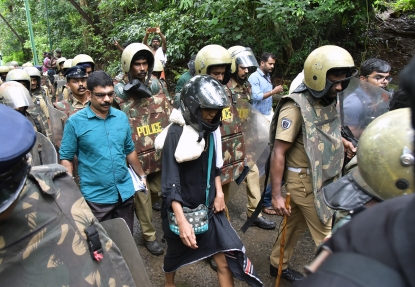 Indian activist Rehana Fatima (C) walks with police wearing protective gear near the Lord Ayyappa temple complex at Sabarimala in India's southern Kerala state on October 19, 2018, after she was denied entry to the temple grounds by Hindu hardliners. (AFP / -)
Indian activist Rehana Fatima (C) walks with police wearing protective gear near the Lord Ayyappa temple complex at Sabarimala in India's southern Kerala state on October 19, 2018, after she was denied entry to the temple grounds by Hindu hardliners. (AFP / -)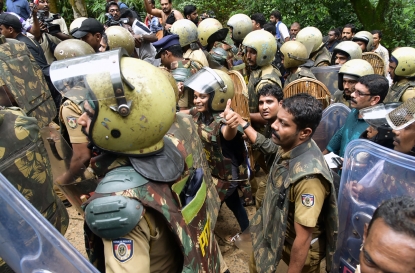 Indian journalist Kavitha Jakkal (C) gestures as she walks with police wearing protective gear near the Lord Ayyappa temple complex at Sabarimala in India's southern Kerala state on October 19, 2018, after she was denied entry to the temple grounds by Hindu hardliners.
(AFP / -)
Indian journalist Kavitha Jakkal (C) gestures as she walks with police wearing protective gear near the Lord Ayyappa temple complex at Sabarimala in India's southern Kerala state on October 19, 2018, after she was denied entry to the temple grounds by Hindu hardliners.
(AFP / -)
I have often seen and faced attacks as a journalist in different parts of India but it was the first time that I saw women journalists being singled out.
With Archana out of danger, Arun and I decided to board a bus packed with devotees to reach Pamba.
By now, things were much more tense. We immediately stood out amongst all the devotees. Many of them asked us if we were journalists, and we reluctantly nodded in agreement. Luckily, at least we weren’t women!\
A half hour had passed with the bus hardly moving when we heard loud screams outside.
Something had happened.
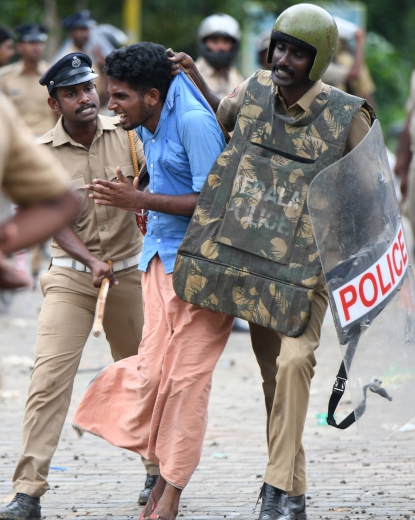 Indian police take a Hindu activist into custody as protesters rallied against a Supreme Court verdict allowing woman to enter the Sabarimala temple, October 17, 2018.
(AFP / Arun Sankar)
Indian police take a Hindu activist into custody as protesters rallied against a Supreme Court verdict allowing woman to enter the Sabarimala temple, October 17, 2018.
(AFP / Arun Sankar)I looked out of the window and saw a young man, his face covered with blood, running from one end of the road to the other. Dozens of men, with stones in their hand, crossed the same stretch of road a few seconds later.
I immediately knew what was happening, as I had seen such scenes many times in the past -- we were in the middle of a full-fledged clash between police and devotees, with both sides pelting each other with stones.
Everyone on the bus ducked down to the floor. Some of the brave ones took out their cellphones to record the action.
There were, maybe four or five women and around 50 men on the bus and none of them had any sympathy for either police or journalists, who to them were interfering with a sacred tradition.
Arun and I jumped out to get closer to the action.
 Police clash with protesters, Kerala State, October 17, 2018. (AFP / Arun Sankar)
Police clash with protesters, Kerala State, October 17, 2018. (AFP / Arun Sankar)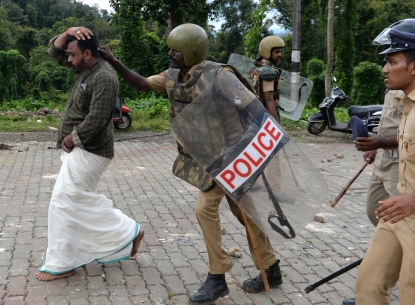 Police clash with protesters, Kerala State, October 17, 2018. (AFP / Arun Sankar)
Police clash with protesters, Kerala State, October 17, 2018. (AFP / Arun Sankar)
The next half hour was really tense and tricky. We ducked the oncoming stones from both sides and ran to avoid getting hit by the projecticles until we finally reached a police cordon.
We spent the next few hours looking at police clash with devotees. Several men were arrested for attacking the police.
The main road was not safe anymore, with rumours of angry devotees attacking media and official vehicles, so we spent the next few hours at a fuel station along with a police party. Luckily, it had good internet and we could send photos and text to our editors.
 Indian police on a road as a shuttle bus rides by toward the Sabarimala temple in Kerala State, October 17, 2018.
(AFP / Arun Sankar)
Indian police on a road as a shuttle bus rides by toward the Sabarimala temple in Kerala State, October 17, 2018.
(AFP / Arun Sankar)It was midnight by the time we got back to our hotel. The local Hindu organisations had already called for a total shutdown for the next day, when we planned to hike up to the temple.
While Arun left for the temple really early next morning, I had to wait to file a story on the shutdown. Our driver, like some others in nearby hotels, refused to leave the safety of the parking lot. The streets and roads were all deserted. It was like a curfew. I had some 60 kilometers to cover to get to Pamba and there wasn't a single vehicle on the road.
To make matters worse, I was in my bathroom slippers. Arun, who is also a devout follower of Ayyappa, had told me to not wear my shoes for the uphill climb -- that way I wouldn’t stand out too much from the others and, as there were no proper shoe lockers around the temple, wouldn’t have my shoes taken while inside. Bathroom slippers seemed like a logical option -- they would provide some cover to the feet and were small enough to be put away if needed.
There was little to do but to start walking. After about two kilometres, I reached protesters blocking the road and was immediately surrounded. I was literally interrogated. Who are you, why are you here, where are you going? I said I was a journalist. Some got even more aggressive after that. To them, media, instead of reporting fairly, was siding with “uninformed arguments” of outsiders about their traditions.
 Indian Hindu activists block a road to the Sabarimala Temple, at Vadaserikara town in Kerala state, October 19, 2018. (AFP / Arun Sankar)
Indian Hindu activists block a road to the Sabarimala Temple, at Vadaserikara town in Kerala state, October 19, 2018. (AFP / Arun Sankar)One of them tried to snatch my phone to see if I had taken pictures of any of them, but luckily a burly man from the group intervened and walked me to the safety of the next intersection, around 300 metres away.
From there, I walked as fast I could until a local on a scooter offered me a ride for a bit. When he dropped me off, I met Sumesh Paik, a polite, chatty local who wanted to help an outsider. He walked with me for a few kilometers and handed me to N.B Sasi Kumar, a local policeman manning a deserted traffic intersection.
Kumar, like everyone else that morning, asked me why I was risking my safety in the curfew-like region. Having learned my lesson from the first roadblock experience, I told him, like I would all others, that I was a tourist and wanted to visit the temple with a friend who was already there.
He helped me hitch a ride with a family, who dropped me off after a few kilometers. There I met a young protester on a motorcycle. The polite man was happy to help a tourist from Delhi who wanted to visit Sabarimala.
 Indian devotees walk to vist Lord Ayyappa temple in Sabarimala in the southern state of Kerala on October 18, 2018. (AFP / Arun Sankar)
Indian devotees walk to vist Lord Ayyappa temple in Sabarimala in the southern state of Kerala on October 18, 2018. (AFP / Arun Sankar)Instead of taking me straight to the bus terminal for pilgrims heading to the temple, he first took me to the nearby protest where a few hundred men were chanting Ayyappa mantras and marching on a deserted street.
I sat behind him and smiled as they all chanted slogans against attempts to alter their tradition.
The man argued how women in Hinduism had lots of freedom and in fact led prayers and most major religious ceremonies, and that the Sabarimala temple ban wasn’t about misogyny but tradition.
He finally dropped me off at the bus terminal. We hugged and took a selfie before he left.
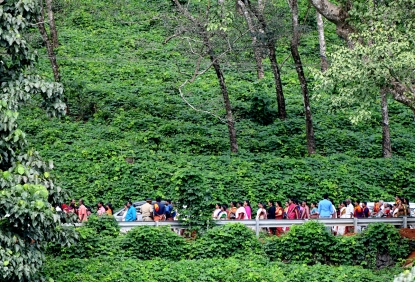 Indian Hindu faithful and activists arrive to take part in a protest against the Supreme Court decision allowing women entry to the Sabarimala temple in Kerala State, October 17, 2018.
(AFP / Arun Sankar)
Indian Hindu faithful and activists arrive to take part in a protest against the Supreme Court decision allowing women entry to the Sabarimala temple in Kerala State, October 17, 2018.
(AFP / Arun Sankar)My excitement and joy at reaching the bus terminal was short lived as I saw the chaos, with hundreds of devotees jostling to board a few buses.
I managed to board one and squeezed myself on the floor next to the driver.
The bus was packed with mostly barefoot and shirtless men, most of them carrying “Irumudi” -- a symbolic offering for the gods in pieces of tied cloth on their heads and shoulders.
I don’t know what was more uncomfortable, my position on the bus, the people’s stares or questions about why I was there. To avoid getting attacked or thrown off the bus, I told whoever asked that I was a tourist.
A couple of hours later, we finally reached Pamba. Now all I had was a three-hour barefoot climb.
 An Indian Hindu devotee is carried on a palanquin to the Lord Ayyappa temple at Sabarimala in the southern state of Kerala on October 18, 2018. (AFP / Arun Sankar)
An Indian Hindu devotee is carried on a palanquin to the Lord Ayyappa temple at Sabarimala in the southern state of Kerala on October 18, 2018. (AFP / Arun Sankar)The bathroom slippers, as I found out in the first 5-10 minutes, are not very helpful if you want to climb an uneven and only partially paved hill.
I joined tens of thousands of others in the pilgrimage. Less than half an hour later, I was huffing and puffing by the side of the road.
I had underestimated the level of dedication and maybe physical fitness needed to make this climb. At one point, I could see young girls, mostly with their fathers or grandparents racing ahead of my slow, ant-like pace.
I sat and chatted with many pilgrims at multiple fresh fruit, juice and snack shacks along the way.
To me, as an Indian, the first striking thing was the diversity. There were people from different socioeconomic backgrounds. I met engineers, plantation workers, drivers, government officers and doctors -- all of them wearing almost the same clothes, sitting together and chanting the same slogans.
In a country otherwise known for its divisions, they were all one and treated others around them as equals.
Many, if not most, didn’t fit the extreme descriptions of opponents of the court decision. Most argued that they’d been misunderstood, and their tradition had been wrongly explained by those who did not understand it themselves.
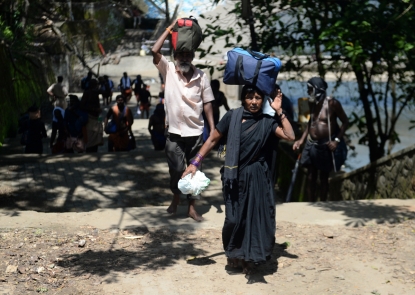 Indian Hindu devotees walk to the Lord Ayyappa temple at Sabarimala in the southern state of Kerala on October 18, 2018. (AFP / Arun Sankar)
Indian Hindu devotees walk to the Lord Ayyappa temple at Sabarimala in the southern state of Kerala on October 18, 2018. (AFP / Arun Sankar)Some of them also justified the anger and the attacks, including on the media.
The one common retort I heard was the perceived difference in treatment of Hinduism and the other two major faiths in the region, Islam and Christianity.
To the uninitiated, the sight of hundreds (if not thousands) of people walking up this narrow path like an endless parade of ants, all chanting the same hymns, was impressive if not hypnotising.
I finished the climb in almost three hours, spotting dozens of local monkeys, wild squirrels, pigs and other wild birds along the beautiful trail.
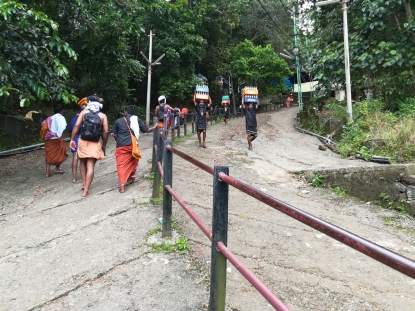 The long climb up to the Sabarimala temple in Kerala State. (Photo courtesy of Bhuvan Bagga)
The long climb up to the Sabarimala temple in Kerala State. (Photo courtesy of Bhuvan Bagga)This was the first time since almost forever that I had walked barefoot for hours, and I still had a long, late-evening descent and an equally adventurous journey to get back to my hotel (which I reached around midnight).
Not used to such harsh treatment, my feet were itchy, swollen and dirty. I soaked them in a bucket of warm water and shampoo (the only thing that I could find) for an hour when I finally reached my hotel. I would have liked to have soaked them for longer, but I was just too tired to sit.
At the summit, Sabarimala -- like so many other ancient Hindu pilgrimages -- is a sight to behold for its sheer scenic setting.
The small, shiny golden exterior of the temple stands out among the lush-green hills all around it.
Maybe it is because of the overpowering tranquil settings of such pilgrimages that Hinduism has historically produced so many famous mystics.
There, standing in a row among tens of thousands of chanting devotees, I could almost forget that the site today is at the epicentre of a massive cultural and religious churn, and political tensions across India.
 The author happy at the top. (Photo courtesy of Bhuvan Bagga)
The author happy at the top. (Photo courtesy of Bhuvan Bagga)


